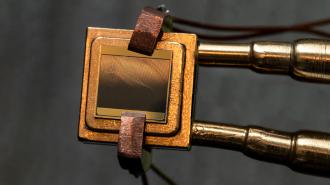Since the Industrial Revolution, steam power has been a mainstay of the modern world. Even today, most of the electricity in the world is produced by steam turbines at coal, gas, and nuclear power plants.
But now, a different kind of heat engine — developed by researchers at MIT and the National Renewable Energy Laboratory (NREL) — is overtaking the efficiency of the steam turbine, potentially unlocking a transformation of how we make and store energy.
The challenge: The cost of producing renewable energy sources has fallen dramatically over the past decade, and in 2020, the International Energy Agency reported that solar had become the cheapest electricity source in history.
Heat engines are devices that convert heat into electricity — steam turbines are the most common example.
Renewables are better for the environment than fossil fuels, too, yet we still rely on coal, oil, and natural gas to produce two-thirds of our electricity, largely because they’re more reliable — we can always burn more fuel, but we can’t make the sun shine or the wind blow.
We can temporarily store excess renewable power in batteries, but because batteries lose charge over time, the storage only lasts days or weeks. That means we can’t bank a ton of solar power from the summer to use in the overcast winter.
Hot topic: Electrical batteries that don’t lose their charge so quickly are in development, but there is another option that could make a renewable grid more reliable: thermal battery systems.
More than 90% of the world’s electricity is generated from heat, in one way or another, and heat engines are the devices that handle the conversion process.
Steam turbines are the most common example — we create heat (usually by burning coal or gas), boil water into steam that spins a turbine, and that mechanical energy is converted into electricity.
“This is the first time thermophotovoltaic cells have gotten into really promising efficiency ranges.”
Andrej Lenert
Thermophotovoltaic (TPV) cells are another type of heat engine — they use semiconducting materials to directly convert the photons from a heat source into electricity.
Like solar photovoltaic cells, TPV cells don’t have any moving parts, which makes them cheaper to maintain than steam turbines. They can also convert higher temperature heat than turbines, which increases their efficiency.
However, TPV cells traditionally haven’t been as efficient as turbines, converting just 20% of the heat energy to electricity compared to steam turbines’ 35%.
MIT’s heat engine: As for how this ties into renewables, we could store energy generated from wind or solar as heat, by heating up tanks of liquid metal in heavily insulated thermal batteries that can store it long-term.
To convert the energy back into electricity, we could use TPV cells to produce electricity from the heat on demand.
In 2019, MIT researchers calculated that getting the efficiency rate of TPV cells up to 35% would make thermal battery systems commercially viable, and with the help of NREL scientists, they’ve now designed one that can convert heat up to 4,350 degrees Fahrenheit into electricity at about 40% efficiency
“Thermophotovoltaic cells were the last key step toward demonstrating that thermal batteries are a viable concept.”
Asegun Henry
The key was using many layers of different semiconductors materials — some absorb photons in mostly visible and ultraviolet wavelengths, while others absorb infrared. A gold-plated mirror in the cell reflects any unabsorbed photons back to the heat source to minimize waste.
“This is very exciting stuff,” Andrej Lenert, a materials engineer at the University of Michigan, who wasn’t involved in the study, told Science. “This is the first time [TPVs have] gotten into really promising efficiency ranges, which is ultimately what matters for a lot of applications.”
Looking ahead: The team’s TPV heat engine is about one square centimeter big. MIT’s Asegun Henry imagines grid-supporting TPV cells about 10,000 square feet big and says systems used to create large photovoltaic cells could be adapted for that manufacturing process.
“Thermophotovoltaic cells were the last key step toward demonstrating that thermal batteries are a viable concept,” said Henry. “This is an absolutely critical step on the path to proliferate renewable energy and get to a fully decarbonized grid.”
We’d love to hear from you! If you have a comment about this article or if you have a tip for a future Freethink story, please email us at [email protected].






